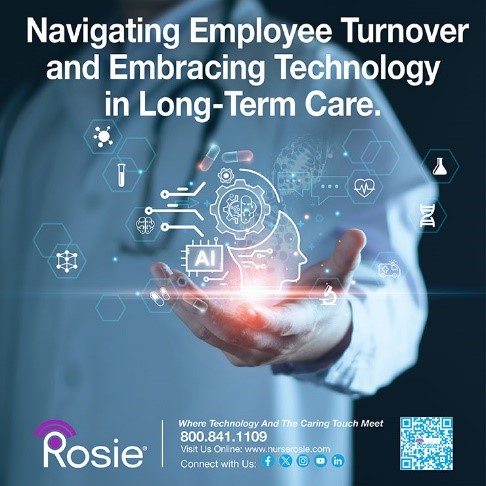
Employee turnover rates are cited as being the number one challenge long-term care facilities are facing. When it comes to helping facilities navigate this storm, Rosie comes with an impressive report card. With years of experience and serving a central role in the industry, Rosie has honed in on the honest challenges that the facilities are facing. Rosie took a step back and took a discerning look at what was desperately needed and then they understood, hands down, that they must deliver a solution that is simple, easy to use and one that always remains connected to the Wi-Fi (even in older, cinderblock buildings). At some of the recent industry conferences, speakers have introduced a promising solution: AI-powered telemetry devices for patients, providing automated vital sign monitoring directly on their skin, reducing the need for manual data collection. While the technology is impressive and inspiring, the path to adopting machine-driven vital sign collection faces hindrances like obtaining FDA clearances, securing insurance approval, meeting CMS reimbursement criteria and the possibility of neglecting enough face-to-face time with the patient.
The government is strongly committed to improving how caregivers and residents interact, emphasizing the importance of human connection in caregiving. While AI-powered devices offer healthcare benefits, the real challenge is to keep the human touch. We must find the right balance, using technology as a tool to support caregivers rather than replacing them. It's not just about technology; it's about keeping the core values of caregiving intact. The future of caregiving depends on successfully combining technology and compassion to provide excellent care to all residents, no matter their needs. Rosie's devices don't replace caregiver-resident interaction; they work alongside caregivers to use technology and compassion for high-quality care.
New technology can be intimidating for some, and implementation of new technologies that change established workflows for staff members is a hurdle for many. Rosie has identified three tips for getting the most out of today's technological investments:
- Find a Champion: Designate a tech-savvy staff member as a "champion" to facilitate the adaptation process. These individuals can provide guidance and support to their colleagues, helping them overcome potential challenges and build confidence in using new systems.
- Start with the Basics: Begin with the fundamentals, ensuring that staff members are comfortable with essential tasks such as device operation, password management, and connectivity. Confidence in these basics is the foundation for adopting more advanced features.
- Encourage Feedback: During and after training, create opportunities for users to provide feedback. By allowing staff to explore and experiment with the technology, you foster a sense of ownership and encourage them to share their insights. This collaborative approach makes staff members feel valued and empowered in the process.
By embracing these principles, long-term care facilities can navigate a path toward a brighter future. They emphasize the synergy between technology and a dedicated staff to enhance care quality and combat high employee turnover. Fostering a culture that embraces technology and compassion as complementary forces is key to delivering top-tier care.